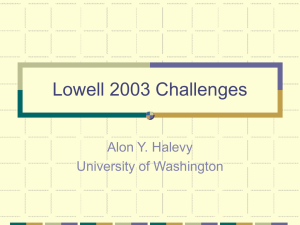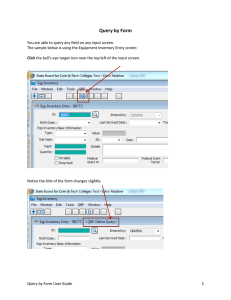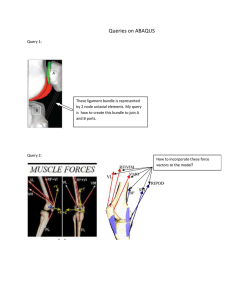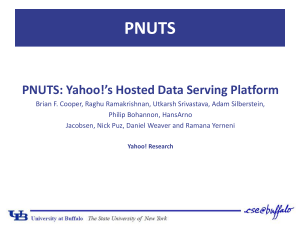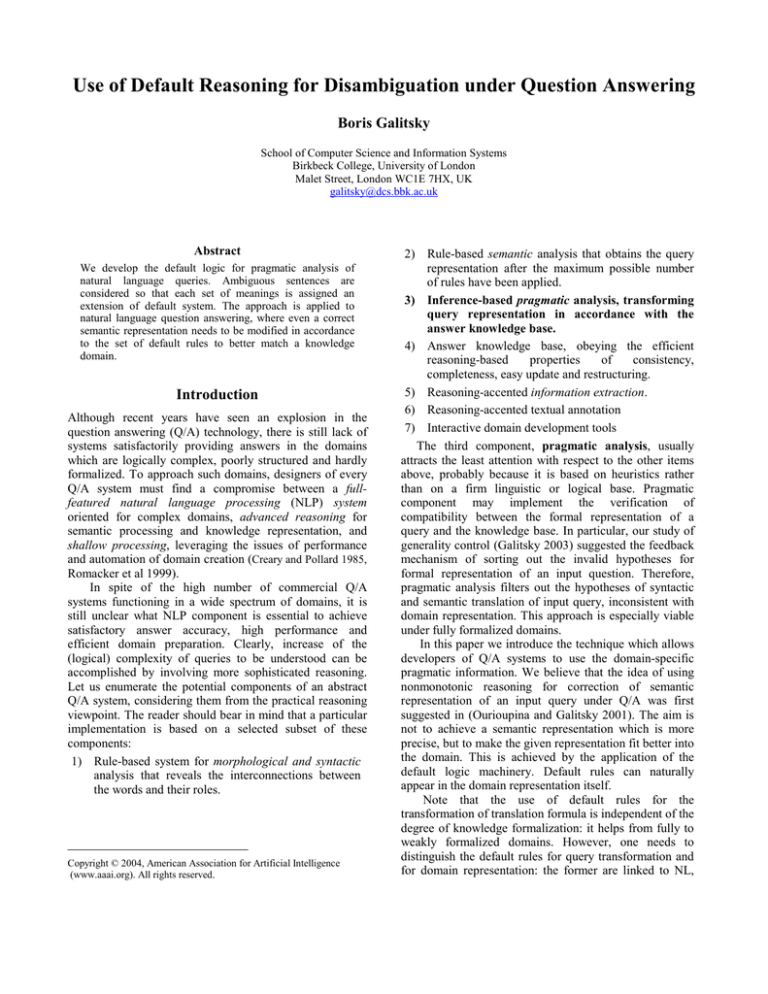
Use of Default Reasoning for Disambiguation under Question Answering
Boris Galitsky
School of Computer Science and Information Systems
Birkbeck College, University of London
Malet Street, London WC1E 7HX, UK
galitsky@dcs.bbk.ac.uk
Abstract
We develop the default logic for pragmatic analysis of
natural language queries. Ambiguous sentences are
considered so that each set of meanings is assigned an
extension of default system. The approach is applied to
natural language question answering, where even a correct
semantic representation needs to be modified in accordance
to the set of default rules to better match a knowledge
domain.
Introduction
Although recent years have seen an explosion in the
question answering (Q/A) technology, there is still lack of
systems satisfactorily providing answers in the domains
which are logically complex, poorly structured and hardly
formalized. To approach such domains, designers of every
Q/A system must find a compromise between a fullfeatured natural language processing (NLP) system
oriented for complex domains, advanced reasoning for
semantic processing and knowledge representation, and
shallow processing, leveraging the issues of performance
and automation of domain creation (Creary and Pollard 1985,
Romacker et al 1999).
In spite of the high number of commercial Q/A
systems functioning in a wide spectrum of domains, it is
still unclear what NLP component is essential to achieve
satisfactory answer accuracy, high performance and
efficient domain preparation. Clearly, increase of the
(logical) complexity of queries to be understood can be
accomplished by involving more sophisticated reasoning.
Let us enumerate the potential components of an abstract
Q/A system, considering them from the practical reasoning
viewpoint. The reader should bear in mind that a particular
implementation is based on a selected subset of these
components:
1) Rule-based system for morphological and syntactic
analysis that reveals the interconnections between
the words and their roles.
Copyright © 2004, American Association for Artificial Intelligence
(www.aaai.org). All rights reserved.
2) Rule-based semantic analysis that obtains the query
representation after the maximum possible number
of rules have been applied.
3) Inference-based pragmatic analysis, transforming
query representation in accordance with the
answer knowledge base.
4) Answer knowledge base, obeying the efficient
reasoning-based
properties
of
consistency,
completeness, easy update and restructuring.
5) Reasoning-accented information extraction.
6) Reasoning-accented textual annotation
7) Interactive domain development tools
The third component, pragmatic analysis, usually
attracts the least attention with respect to the other items
above, probably because it is based on heuristics rather
than on a firm linguistic or logical base. Pragmatic
component may implement the verification of
compatibility between the formal representation of a
query and the knowledge base. In particular, our study of
generality control (Galitsky 2003) suggested the feedback
mechanism of sorting out the invalid hypotheses for
formal representation of an input question. Therefore,
pragmatic analysis filters out the hypotheses of syntactic
and semantic translation of input query, inconsistent with
domain representation. This approach is especially viable
under fully formalized domains.
In this paper we introduce the technique which allows
developers of Q/A systems to use the domain-specific
pragmatic information. We believe that the idea of using
nonmonotonic reasoning for correction of semantic
representation of an input query under Q/A was first
suggested in (Ourioupina and Galitsky 2001). The aim is
not to achieve a semantic representation which is more
precise, but to make the given representation fit better into
the domain. This is achieved by the application of the
default logic machinery. Default rules can naturally
appear in the domain representation itself.
Note that the use of default rules for the
transformation of translation formula is independent of the
degree of knowledge formalization: it helps from fully to
weakly formalized domains. However, one needs to
distinguish the default rules for query transformation and
for domain representation: the former are linked to NL,
and the latter are supposed to be language-independent.
Though the default reasoning technique is applicable to a
variety of semantic analysis approaches, the particular set
of default rules is domain-specific.
Default reasoning seems to be well suited to represent
the semantic rules which process the ambiguous terms. In a
horizontal domain, a term may have a set of meanings such
that each of them is important and needs separate
consideration.
For a vertical (narrow) domain, an
ambiguous term usually has one common meaning and
multiple infrequent meanings which still have to be
formally represented. The system may assume the default
meaning of this term unless it is inconsistent to do so. This
inconsistency can be determined based on the occurrence
of some words in a sentence, or some terms in the
translation formula (formal representation of an input NL
question). We refer the reader to (Hirst 1988, Creary and
Pollard 1985) for discussions of the disambiguation
problem.
In this study we evaluate the application of default
reasoning to the domain based on semantic headers
(Galitsky 2003). However, the proposed technique is
representation-independent and can be combined with any
approach to semantic analysis, achieving a certain level of
formalization (Sondheimer et al 1984, Ciravegna and
Lavelli 1999). Note that nonmonotonic reasoning is
suggested here for query processing and not for knowledge
representation.
From the perspective of nonmonotonic reasoning,
linking the semantic representation of a query with that of
answers, additional (lexical) data in a query may switch the
resultant pattern (answer). Such nonmonotonicity would be
considered as a non-desired property in the standard
(statistical or structural) pattern recognition settings:
discovering an additional feature of an input stimulus is not
supposed to alter the resultant pattern. This is not the case
for the pattern recognition under Q/A: an occurrence of an
additional word which may seem insignificant being standalone, may cause a totally different answer for a query. We
believe explicit nonmonotonic reasoning machinery is an
appropriate means to handle this phenomenon of NL-based
recognition systems.
Basics of Default Reasoning for Question
Answering
An abstract default logic (as proposed by (Reiter 1980))
distinguishes between two kinds of knowledge, usual
predicate logic formulas (axioms, facts) and “rules of
thumb” (defaults). Default theory (Brewka et al 1995,
Bochman 2001) includes a set of facts which represent
certain, but usually incomplete, information about the
world (query, in our case); and a set of defaults which
cause plausible but not necessarily true conclusions (for
example, because of ambiguity). In the case of textual
knowledge representation, some of these conclusions have
to be revised when additional context information becomes
available.
Division of knowledge into the fixed (facts) and
flexible (rules) components may serve as a good model of a
textual message or an arbitrary portion of text, taken
separately from its context. Some statements are contextindependent and have a single meaning, other statements
have context-dependent meanings and can be determined
after the context is established, and a third group of
statements is ambiguous in as exact a context as possible.
As we have said, in this work we use the system of default
rules to modify the formal representation of a textual
answer for the sole purpose of question answering and not
to better represent the text meaning itself ( or knowledge of
an arbitrary nature). The latter problem is the subject of
future studies.
Let us consider the traditional example quoted in the
literature on nonmonotonic reasoning:
bird(X): fly(X)
fly(X)
One reads it as If X is a bird and it is consistent to assume
that X flies, then conclude that X flies. As a Q/A matching
rule default, it reads as follows If the query is about the
bird, and it is consistent to assume that there can be a
word in this query with the meaning of flying, then
conclude that the query is about flying. If nothing
contradictory can be derived from the other words of the
query, it is natural to assume that this query is about the
flying of a bird.
As a traditional default, we obtain the assumption
Usually (typically) birds fly. Given the information that
Tweety is a bird (in accordance with the history of
nonmonotonic reasoning) we may conclude that he flies.
But if we learn later that he cannot fly, for example,
because he is a penguin, then the default becomes
inapplicable.
The nonmonotonic reasoning technique (see e.g.
(Bochman 2001)) helps us to provide the proper Q/A in
this situation. Imagine that we have a set of documents
answering questions about birds. Let us imagine there is a
general answer, which presents information that birds fly,
and which contains common remarks. Besides, there is also
a specific answer, stating that there is a bird Tweety, who is
a penguin, lives at the South Pole, swims, but does not fly.
If there is no processing of the translation formula, then
the explicit restriction for the semantic representation will
look like the following. The possible questions are Do
birds fly?, Tell me about birds, Which animals fly?, Do
seagulls fly?, What do you know about eagle birds?, Is
Tweety a bird?, Does Tweety fly?, Is Tweety a penguin?;
they will cause the same answer that birds fly, unless we
mention the bird Tweety.
bird(X), not(X=Tweety) → answer(birds fly).
fly(X), not(X=Tweety) → answer(birds fly).
bird(Tweety) → answer(there is a bird Tweety, which is a
penguin, lives at the South Pole, swims, but does not fly).
fly(Tweety) → answer(there is a bird Tweety, which is a
penguin, lives at the South Pole, swims, but does not fly).
The problem with this approach is that it requires
explicit enumeration of constraints in knowledge base.
Each exceptional object has to be enumerated in the
representation, which includes the properties of normal
objects. When default rules come into play to modify the
translation this complication is avoided. The first answer
does not have to contain explicit constraints that X is not
Tweety or some other object; it will be reached if it is
consistent to assume that fly(X). The latter is verified using
the default rule above and the clause that Tweety does not
fly.
Here is a formal definition of default rule, as proposed in
(Antoniou 1997). A default δ has the form:
ϕ: ψ1,…, ψn
δ =
χ
where ϕ, ψ1,…,ψn ,χ are closed predicate formula and n>0.
The formula φ is called the prerequisite, ψ1,…,ψn the
justification, and χ the consequent of δ (pre(δ), just(δ) and
cons(δ) correspondingly). A default δ is applicable to a
deductively closed set of formulae Ε iff ϕ∈Ε and ¬ψ1∉ Ε,
…, ¬ψn∉ Ε .
Note that it is inefficient to encode the rules for typical
and non-typical situations on the same level of their
potential application. Instead, all abnormalities should be
merged and linked with the negation of justification of the
default rule. The prerequisite of this rule should include the
typical conditions.
Operational Semantics
In an abstract rule-based system, the inference (or
recognition) result depends on the order of rule
applications. The operational semantics of default logic
come into play to handle the possible order of application
of the conflicting default rules. In this Section we propose
an informal description of operational semantics for default
reasoning. Formal definitions, theorems and proofs can be
found, for example, in (Antoniou, 1997).
The main goal of applying default rules is to make all the
possible conclusions from the given set of facts. If we
apply only one default, we can simply add its consequent to
our knowledge base. The situation becomes more
complicated if we have a set of defaults because, for
example, the rules can have consequents contradicting each
other or, a consequent of one rule can contradict the
justification of another one. In order to provide an accurate
solution we have to introduce the notion of extensions:
current knowledge bases, satisfying some specific
conditions.
Suppose D is a set of defaults and W is a set of facts
(our initial knowledge base). Let ∆ be an ordered subset
of D without multiple occurrences (it is useless to apply
the default twice because it would add no information).
We denote a deductive closure (in terms of classical logic)
of ∆ by In(∆): W ∪ {cons(δ)δ∈∆}. We also denote by
Out(∆) the set {¬ψψ ∈ just(δ), δ∈∆}. We call ∆={δ0,
δ1,…}a process iff for every k δk is applicable to In(∆k),
where ∆k is the initial part of ∆ of the length k.
Given a process ∆, we can determine whether it is
successful and closed. A process ∆ is called successful iff
In(∆)∩Out(∆) = ∅ . A process ∆ is called closed if ∆
already contains all the defaults from D, applicable to
In(∆).
Now we can define extensions. A set of formulae E⊃W
is an extension of the default theory <D, W> iff there is
some process ∆ so that it is successful, closed, and
E=In(∆).
The following example (life insurance Q/A domain)
shows that there can be multiple extensions for one set of
facts and default rules:
dangerous_job(X): insure_life(X)
δ1
insure_life(X)
young(X): not insure_life(X)
δ2
not insure_life(X)
These rules explain that people with dangerous jobs
usually insure their lives and young people normally do
not. This is knowledge required to answer the question
Am I advised to have life insurance as a teenager? Let us
suppose that we want to conclude something about a
young
man
who
has
a
dangerous
job:
W={dangerous_job(X), young(X)}. After the application
of each default, the other one becomes inapplicable. So,
both {δ1}and{δ1}are closed and successful processes.
Thus, both {dangerous_job(X), young(X), insure_life(X)}
and {dangerous_job(X), young(X), not(insure_life(X))}
are the extensions.
Pragmatic Analysis with the Help of Default
Rules
Suppose S is a semantic representation of a query. Our
intention is to transform S into another well-formed
semantic representation, @S (about S), which fits our
narrow domain better because it takes into account default
domain knowledge. Note that the latter is not necessarily
explicitly mentioned in a NL query, so the transformation
above is required. To perform it, the following algorithm
is proposed: using a set of facts like word X is used in S
and word X is not used in S as an initial knowledge base,
we can apply default rules (created manually by
knowledge engineers) to obtain all the possible
extensions. These extensions contain facts about elements
of @S (as well as initial statements). After doing that we
can use the extensions to build up the @S representation.
It includes the n-conjunction of initial facts (word
occurrences in a query Xi) and their specific meanings
@Xj : @S= & (Xi , @Xj,)
i,j < n
Note that S (and not @S) is indeed the most precise
representation of the query meaning, taken separately.
However, S needs to be transformed to point to the
desired answer with higher accuracy. This transformation
is intended to eliminate the least important entities so as
not to interfere with the most important ones, as well as to
add the implicitly assumed elements.
There are two possible ways to use default systems to
modify semantic representations:
•
•
Application of defaults in the fixed order. This can
be used when there are no conflicts in the
consequents of the default rules.
Building extensions for conflicting defaults. We
employ the operational semantics of default logic in
more complex situation, for example, when we have
multiple ambiguous terms in a query (Fig. 1).
Facts Si ,
comprising the
query
representation
(occurrences of
words in a query)
Successful &
closed process:
extension
@S1, @S2 ,…
→ answer 1
Default rules, establishing the
meanings of words based on the
other words and the meanings
that have been established
Successful &
closed process:
extension
@S3, @S1 ,…
→ answer 2
Either
unsuccessful or
non-closed
process:
No extension
Fig.1 Question answering architecture which provides multiple
answers as a result of default reasoning
If we do not want to modify initial representation at all
(S=@S), we can apply trivial defaults to each element of
S:
X is used in S: X is used in @S
X is used in @S
All the facts in our knowledge base are about the
element occurrence: it is either used in the representation
or not. In our rules we can write X instead of X is used in S
and @X instead of X is used in @S, not causing any
confusion. Sometimes we will speak about entities X and Y
connected semantically or syntactically. In that case we
would write X(Y), which means that X is used in S, Y is
used in S and X and Y are connected by semantic or
syntactic link. In this form trivial rules look like:
X: @X
@X
We can use these defaults not only when we want to have
S unmodified. In fact, we should apply trivial rules to every
representation. Elements which are not affected by
nontrivial defaults are simply moved from S to @S. As far
as other elements are concerned, trivial and nontrivial rules
can interact with each other, leading to specific extensions.
Processing ambiguous terms
Ambiguous elements correspond to multiple default rules.
Let us consider an example from an insurance domain.
The word company is ambiguous: it can refer either to
insurance company or to company where the customer
works. In default form it looks like:
company():@insurance_company(),not @place_of_work
δ:
@insurance_company()
company():not @insurance_company(), @place_of_work
ε:
@place_of_work
If we have no other entities in the query which can help us
to make a decision on what company is meant, both rules
(δ and ε) can lead to an extension. As a result we have two
representations @Sδ and @Sε, and two respective answers.
However, if the query contains some words
incompatible with one of the meanings proposed, then one
of the rules does not lead to an extension. For example, if
the query is about companies ratings (What is the best
company?) then it is about insurance_company rather
than about place_of_work. Note that this rule of thumb
holds for the narrow domain on insurance. If a person
looks for a job-related domain, the Q/A system’s decision
should be the opposite one. And in the everything-aboutthe-world domain we cannot create such rules at all. As a
default rule, it looks like the following:
company(rating): @insurance_company()
α:
@insurance_company(rating)
Consequent of α contradicts a justification of ε. That is
why there can be no extension created by means of ε: ε is
inapplicable after α, α is still applicable after ε, but it
makes the process unsuccessful.
If the query contains no information which can help us to
perform the query disambiguation, default rules lead to
multiple extensions, corresponding to multiple meanings of
ambiguous elements. If the query contains some specific
concepts, our rules lead to single extension and the system
proposes a single answer. We believe that the optimal
solution for a Q/A system is to provide multiple answers in
case of multiple extensions (i.e. in case there are no words
indicating the particular meaning).
Default rules can help us to add new elements to
semantic representation, using the basics of commonsense
knowledge. Frequently, it is necessary to insert an entity
which links the specific attribute with the more general
concept occurring in a query. For example, if the query
contains word school it is likely to be about education. So
Can I deduct my school expenses? should be interpreted as
deduct(expense(education(school()))). We propose the
following default rule:
school(): @education()
@education(school())
This rule should be accompanied by the clause presenting
situations of justification inconsistency. If we have a query
Can I deduct my donation to a catholic school?, it is about
a donation rather than about education. The following
clause provides the proper solution:
@education :- deduct(Attribute),
not( Attribute =expense).
The rule above expresses the fact that if there are attributes
of deduct in a query, then the query is likely about these
attributes (donation, construction, moving, etc.). If
Attribute is rather general (expense), then the clause fails
and justification stays consistent.
Let us consider another example when we add an entity
(donation) to the query representation to link the specific
word (church) to a general concept (deduct): Can I deduct
what I gave to church? We have similar default rule:
church(): @donation()
@donation(church)
Furthermore, what would happen if we have more than
one specific word potentially connected with the general
concept, as in a query Can I deduct my church school
expenses? Occurrence of multiple attributes may require
analysis of conflicting defaults (operational semantics). If
the justification failure clause for @donation is similar to
that proposed above, we have two extensions for this query
- {…, @donation} and {…,@education}. But if we
consider education to be more general than donation, the
justification failure clause looks like
@donation:- deduct(Attribute),not(Attribute=expense),
not(Attribute=education),
and the only possible extension is {…, @donation}.
The default technique indeed brings in significant
advantages in the processing of poorly structured (NL)
knowledge representation. If we do not want to use default
technique for our school example then, either we are not
able to substitute school() in the formula at all or, we have
to use deduct(expense(school())) representation. In the first
case we lose important information and obtain a wrong
answer. In the second case we have to provide the
possibility to substitute university, college, institute, and
other terms in expense() as well. As a result the domain
becomes less structured and query processing loses
efficiency.
As we have seen, default rules can help us to improve
domain hierarchy. It affects not only the performance but
also the quality of query processing. Let us imagine that we
have no information about school expenses. Instead, we
know how to treat educational expenses in general. If the
system cannot connect school with education, users get
wrong
answers
because
the
formula
deduct(expense(school())) is interpreted literally.
Semantic representation can contain more or less
specific entities. The most general parts can lead to vague
answers. For example, the query How to file time extension
for
my
tax
return?
has
a
representation
tax(return)&extension(file). It leads to two answers: about
tax returns in general and about extension of time for filing.
It is obvious that the first part is redundant and must be
eliminated. In fact, in tax domain we can interpret
extension only as extension of time to file, and not for
example, as extension of computer file. Therefore,
tax(return) can be deleted from the formula without loss of
information. We first present the naïve stand-alone rule:
extension(time): tax
@extension()
This rule can be read as follows: if a query mentions
extension of time and it is consistent to assume that it is
about tax, then the query is indeed only about extension.
Although this rule follows our intuition better, it is not
appropriate for interaction with other rules, because it does
not actually eliminate tax from the current knowledge base.
Therefore, we suggest the following rule instead:
extension(): not @tax()
δ:
not @tax
It is read as follows: if a query contains the word extension,
then tax should be eliminated. Note that the elimination of
redundant elements is connected with the disambiguation
problem. If we have no idea about the topic of the query,
both meanings (filing time extension and computer file
extension) are probable, so we need an additional
information to apply our analysis to. However, if we
provide the Q/A for a narrow domain, only one meaning is
expected and the other is exceptional. That is why this
additional information becomes redundant.
To comment on the rule δ we present the simplified
default “without extension”, which would mean that we can
always eliminate tax from a query.
⊥: not @tax()
not @tax
However, this rule would misinterpret the queries What is
tax?, Can I deduct the tax I paid last year?, and others.
Depending on the order in which rules of eliminating
redundant parts and trivial rules are used, we can obtain
several extensions containing more or less elements of the
initial structure, because these two types of defaults make
each other inapplicable. If we begin with trivial rules, the
representation remains unmodified. Otherwise, some
entities are eliminated. The order in which defaults are
applied can be chosen by knowledge engineers depending
on the task specifics.
Conclusions
Misunderstanding
No
understanding
No
knowledge
Correct
answer
Domain
development step
In conclusion, we outline the semantic role of the suggested
approach. Generally speaking, default rules are used to
convert a formal representation of an NL question in the
form which is adequate as a knowledge base query. Such
the conversion is required even for a semantically correct
representation of a given query. The set of default rules
with consequents that correspond to a single knowledge
base query covers semantically different, but pragmatically
similar questions. Syntactically different questions are
handled on the earlier stage (at a lower level with respect to
a knowledge base); however, application of default rule is
capable of correcting a wrong syntactic or semantic
processing.
As to the quantitative measure of how the Q/A
accuracy can be improved by applying default rules, we
present the data for the domain on retirement saving, which
is quite narrow. This domain contains 1200 generalized
questions (semantic headers), 400 answers prepared by an
expert, and is subject to testing by 5000 questions most of
which were supplied by customers. In the Table 2 below
we show the percentages of the above questions which
were properly answered, caused situations where there was
no appropriate knowledge available, led to a lack of
understanding or a wrong answer. As we see, the overall
accuracy was increased by 15 percent. It included 4.6
percent cases when the query modification lead to a
successful run against a knowledge base versus a void run
without such mofification, and 10.4 percent when a better
answer was returned.
Before using default
65
7
9
19
rules
After using default
75
7
6
12
rules
Table 2: Percentages of correct/wrong answers before and after
default rules were used to transform the formal representation of
input query.
One of motivations of our study of default reasoning
for Q/A is the lack of convincing, from our viewpoint,
examples of practical default reasoning, and especially the
operational semantics of default reasoning. The verbal
description highlights “usual” (default) and “unusual”
circumstances but, as only the data is formalized and there
are conflicting rules while computing the extensions,
intuitive perception of being usual and unusual dissipates.
Only thorough consideration of natural language scenarios,
presented within a vertical domain, may serve as a
satisfactory illustration of practical nonmonotonic
reasoning. Nontrivial extensions induced by a query appear
when this query has multiple ambiguities. In particular, the
situations where two words or multi-words have double
possible meanings each such that the sentence has at least
three overall meanings, are relatively rare (Krijevsky and
Galitsky 2002).
NLP offers unique possibilities to apply nonmonotonic
reasoning to a domain which is sufficiently complex in
terms of knowledge structure on one hand and possess the
intrinsic feature of having a typic and an atypical meanings
on the other hand. Advanced theoretical investigations have
been carried out in order to build the formal background
for nonmonotonic intuition and a series of counterexamples (see e.g. Pascu and Carpentier 2002). However,
the number of practical applications of nonmonotonic
reasoning is far below the number of the theoretical results
and their value. We believe that this study contributes to
restoration of the balance between theoretical and applied
issues of default reasoning.
References
Antoniou, G. 1997. Nonmonotonic reasoning. MIT Press
Cambridge, MA London England.
Brewka, G., Dix, J., Konolige, K. 1995. Nonmonotonic
reasoning: an overview. CSLI Lecture Notes 73.
Bochman, A. 2001. A Logical Theory of Nonmonotonic
Inference and Belief Change. Springer Verlag.
Ciravegna, F. and Lavelli, A. 1999. Full text parsing using
cascades of rules: an information extraction perspective. In Proc
9th European ACL Conf., Bergen Norway.
Creary, L.G. and Pollard, C.J. 1985. A computational semantics
for natural language. In Proc ACM-85 pp. 172-179.
Galitsky, B. 2003. Natural Language Question Answering
System: Technique of Semantic Headers. Advanced Knowledge
Intl., Adelaide Australia.
Hirst, G. 1988 . Semantic interpretation and ambiguity. Artificial
Intelligence 34 2, pp.131-177.
Krijevskiy, P., Galitsky, B. 2002. Building extensions of default
logic to represent ambiguous sentences. DIALOGUE:
International Workshop on Computational Linguistics, Russia.
Ourioupina O., Galitsky B. 2001. Application of default
reasoning to semantic processing under question-answering
DIMACS Tech Report 2001-16, May 2001.
Pascu,A. Carpentier, F.-G. 2002. Object Determination Logic A Categorization System. FLAIRS Conference, 178-180.
Reiter R. 1980. A logic for default reasoning. Artificial
Intelligence 13, pp. 81-132.
Romacker, M., Markert, K., Hahn, U. 1999. Lean semantic
interpretation, In Proc International Joint Conference on
Artificial Intelligence-99, pp.868-875.
Sondheimer, N.K., Weischedel R.M., and Bobrow, R.J. 1984.
Semantic interpretation using KL-One. In COLING-84, 101-107.


